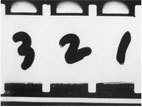On Duration in Film
- Takahiko Iimura |
- 1972-2010 |
- 39 minutes |
- B&W |
- SOUND
This dvd includes two films:
2 Minutes 46 Seconds 16 Frames (100 feet) 1972/2010, 16mm/dvd, 8min. 33sec.
1 To 60 Seconds 1973/2010, 16mm/dvd, 30min.30sec.
"I asked John Cage about his piece 3 Minutes 44 seconds(1952), discussing the conceptual title of the piece. Time itself becomes thetitle of the piece. John said that it's not just the time but also a space, and I responded by discussing the Japanese concept of ma, which is a concept that construes time and space as inextricably linked.I also made a piece called 2 Minutes 46 Seconds 16 Frames (100 feet), made in 1972, which was inspired by his piece.In the beginning, I chronologically wrote down the numbers one totwenty-four on each frame for 100 feet of film.Then I chronologically wrote down the numbers one to sixty, but this time every second (every 24 frames),and did this twice. It was an attempt to show that time is alsodistance,
especially with film."
-Takahiko IImura, from the interview by Julian Ross, 2010
"A screening of 1 To 60 Seconds at Utica college in 1976 is a case in point...After a few seconds many members of the audience had recognized that the numbers were in some definite order and that the passages of dark leader which separated the frameswith the numbers
had some specific relationship to numbers themselves.....everyone I talked with or saw was intensely experiencing the film by remaining acutely conscious of the passage of time and of the stately progression of Iimura's film in the theater."
-Scott MacDonald, Afterimage, April.1978
"In 1 To 60 Seconds Iimura does an extrordinary thing: he abstracts time from any concrete associations, seems to put it on the screen and there you sit looking at (or for) it, experiencing it. The film is all black leader except for the numbers 1 to 60 that appear individually in sequence to indicate the amount oftime in seconds that each of them followed one second leter by a number or numbers indicatin the total amount of timethat has thus far transpired. So at each juncture you know beforehandhow much time awaits you before the next and how much is behind you, and then it's just you and the black screen."
-Paul Poggiali, The Soho Weekly News, New York,May 9 , 1974


